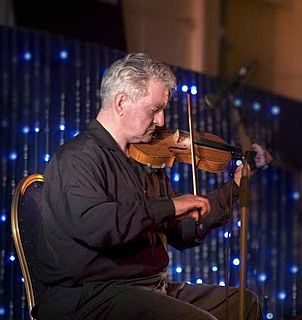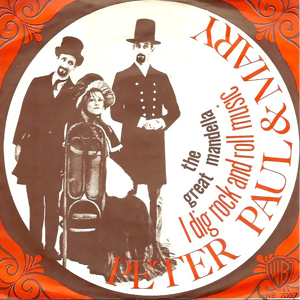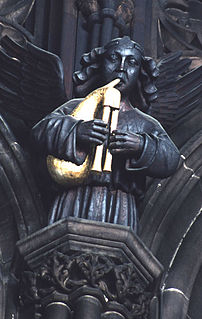Related Research Articles

Bagpipes are a woodwind instrument using enclosed reeds fed from a constant reservoir of air in the form of a bag. The Scottish Great Highland bagpipes are the best known examples in the Anglophone world, but people have played bagpipes for centuries throughout large parts of Europe, Northern Africa, Western Asia, around the Persian Gulf and northern parts of South Asia.

The Donegal fiddle tradition is the way of playing the fiddle that is traditional in County Donegal, Ireland. It is one of the distinct fiddle traditions within Irish traditional music.

Claves are a percussion instrument consisting of a pair of short, wooden sticks about 20–25 centimeters long and about 2.5 centimeters in diameter. Although traditionally made out of wood many modern manufacturers offer claves made out of fiberglass or plastic.

Willard Palmer Harris was an American jazz trombonist.
Drone music, drone-based music, or simply drone, is a minimalist genre that emphasizes the use of sustained sounds, notes, or tone clusters – called drones. It is typically characterized by lengthy audio programs with relatively slight harmonic variations throughout each piece. La Monte Young, one of its 1960s originators, defined it in 2000 as "the sustained tone branch of minimalism".
Emma Christian is a prominent artist in the recent revival of traditional Manx folk music.

The Celtic fiddle is one of the most important instruments in the traditional repertoire of Celtic music. The fiddle itself is identical to the violin, however it is played differently in widely varying regional styles. In the era of sound recording some regional styles have been transmitted more widely while others have become more uncommon.

"I Dig Rock and Roll Music" is a 1967 song by the American folk group Peter, Paul and Mary, written by Paul Stookey, James Mason and Dave Dixon.

When bagpipes arrived in England is unknown, there is some evidence to suggest Anglo-Saxon times, however the oldest confirmed proof of the existence of bagpipes anywhere in the world comes from three separate sources in the 13th century. Two of them English; the Tenison Marginalie Psalter from Westminster and an entry into the accounts books of Edward the I of England recording the purchase of a set of bagpipes. The third from the Cantigas Del Santa Maria published in Spain. From the 14th century onwards, bagpipes start to appear in the historical records of European countries, however half the mentions come from England suggesting Bagpipes were more common in England.
Joe Hicks is an American R&B and soul blues singer and songwriter. He hailed from San Francisco, California, United States, and found limited success in the late 1960s and early 1970s. Hicks recorded an album for a subsidiary label of Stax Records.
Reel pipes are a type of bagpipe originating in England and Scotland. These pipes are generally a scaled-down version of the large Great Highland pipes. Reel pipes are generally quieter than the Great Highland pipes, so suitable for indoor play.
Linford Anderson aka Andy Capp is a Jamaican studio engineer, producer, and vocalist, best known for his 1968 hit "Pop a Top".

The tambouras is a Greek traditional string instrument of Byzantine origin. It has existed since at least the 10th century, when it was known in Assyria and Egypt. At that time, it might have between two and six strings, but Arabs adopted it, and called it a Tanbur. The characteristic long neck and two strings, tuned five notes apart.
Na Píobairí Uilleann is a non-profit organization dedicated to the promotion of the Irish Uilleann pipes and its music.
John Hunsley was a bagpiper from Manton, North Lincolnshire and last known player of the Lincolnshire bagpipes, which he played until shortly before his death at around 1850.

The Korg VC-10 is an analogue vocoder launched in 1978. Vocoding refers to voice encoding of speech and singing with musical synthesis. It gained popularity in the 1970s following utilisation by bands such as Kraftwerk and Electric Light Orchestra. The VC-10 allows basic functionality in operation and modulation of signal carriers. It has two microphone input options.
Charles Remue was a Belgian clarinetist, alto saxophone player and bandleader of early jazz, who, while leading a band called Chas. Remue & His New Stompers, recorded what are widely considered to be the first jazz discs by a Belgian band.

Pandit Devabrata (Debu) Chaudhuri was an Indian sitarist and teacher. He was conferred the Padmabhushan and Padma Shri awards. He was the writer of six books, composer of eight new ragas and numerous musical compositions. From 1963 he has appeared in numerous radio broadcasts, and he was a disciple of Mushtaq Ali Khan. He is considered a leading sitarist of Post War era. He is regarded as one of the leading proponents of Senia Style. He was the former Dean and Head, Faculty of Music, University of Delhi. His music is noted for its sweet singing ringing tone. He lived with his son, daughter-in law and niece at Chittaranjan Park, New Delhi.

Raga Mala is an autobiographic work by Indian classical musician Ravi Shankar, published in 1997 as a hand-bound, limited edition book by Genesis Publications. The initial print run was limited to 2000 signed and individually numbered copies, with a foreword by George Harrison, who also served as Shankar's editor. In addition, Oliver Craske was credited with providing "additional narrative".

The Duet concertina is a family of concertinas, distinguished by being unisonoric and by having their lower notes on the left and higher on the right.
References
- ↑ John Shepherd. Continuum encyclopedia of popular music of the world: VolumeII: Performance and production, Volume 11. Continuum International Publishing Group, 2003. ISBN 0-8264-6322-3, ISBN 978-0-8264-6322-7. p. 469
- ↑ Fintan Vallely. The companion to Irish traditional music. NYU Press, 1999. ISBN 0-8147-8802-5, ISBN 978-0-8147-8802-8. p. 18